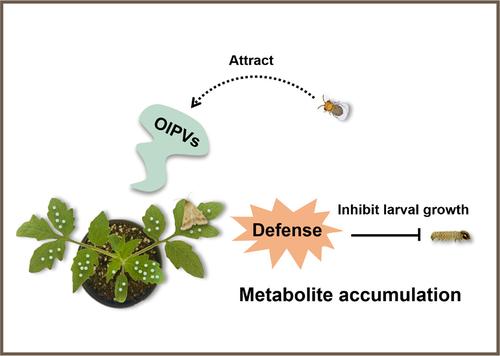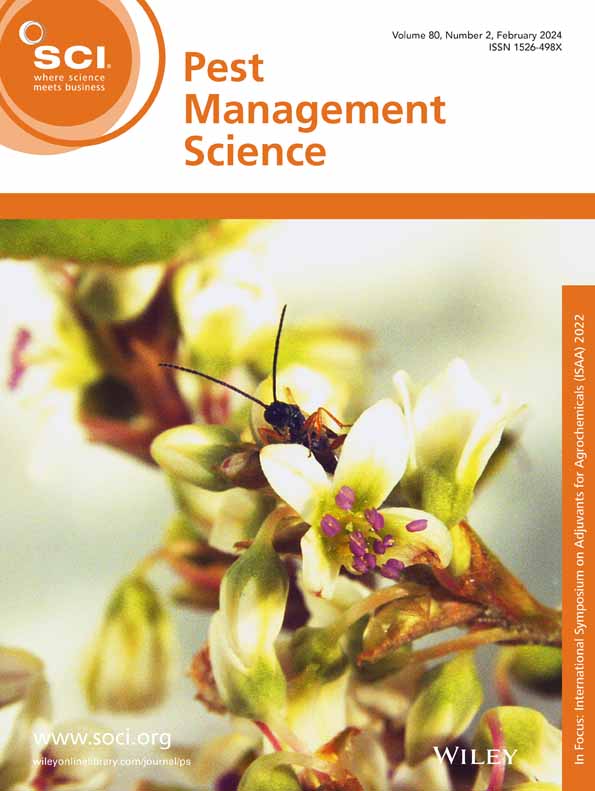The oviposition of cotton bollworms stimulates the defense against its eggs and larvae in tomato plants
IF 3.8
1区 农林科学
Q1 AGRONOMY
Jin‐Hua Shi, Rui Shao, Sara T Abdelkhalek, Shuo Zhang, Man‐Qun Wang
求助PDF
{"title":"The oviposition of cotton bollworms stimulates the defense against its eggs and larvae in tomato plants","authors":"Jin‐Hua Shi, Rui Shao, Sara T Abdelkhalek, Shuo Zhang, Man‐Qun Wang","doi":"10.1002/ps.8521","DOIUrl":null,"url":null,"abstract":"BACKGROUNDHerbivorous insects sustain their populations by oviposition. To reduce the damage caused by herbivores, the host plant triggers a defensive response upon detection of egg deposition. However, the specific impact of the egg deposition time of the cotton bollworm <jats:italic>Helicoverpa armigera</jats:italic> (Lepidoptera: Noctuidae), on the tomato plant defense remains obscure.RESULTSThis study investigated the effects of tomato plant defenses on cotton bollworm eggs and larvae at different time intervals following egg deposition. The study revealed that tomato plant defense triggered by egg deposition did not directly affect the hatchability of the eggs. Nevertheless, it attracted <jats:italic>Trichogramma chilonis</jats:italic> 48 h after the egg deposition. Gas chromatography–mass spectrometry analysis of the oviposition‐induced plant volatiles (OIPVs) revealed a considerable increase in the amount of <jats:italic>α</jats:italic>‐pinene released by tomato plants 48 h after egg deposition. The olfactory results from Y‐tube experiments showed that <jats:italic>α</jats:italic>‐pinene exhibited a substantial attraction towards <jats:italic>T. chilonis</jats:italic>. In addition, it was found that the defense response induced by egg deposition for 24 and 48 h significantly inhibited the growth and development of the larvae. Metabolomics analysis revealed that the egg deposition of cotton bollworm altered the metabolite composition and caused significant modifications in the metabolic pathways of tomato plants.CONCLUSIONThese findings provide novel insights into pest management by using egg‐induced plant defenses to reduce egg hatching, and impede larval growth and development in herbivorous insects. © 2024 Society of Chemical Industry.","PeriodicalId":218,"journal":{"name":"Pest Management Science","volume":"35 1","pages":""},"PeriodicalIF":3.8000,"publicationDate":"2024-11-08","publicationTypes":"Journal Article","fieldsOfStudy":null,"isOpenAccess":false,"openAccessPdf":"","citationCount":"0","resultStr":null,"platform":"Semanticscholar","paperid":null,"PeriodicalName":"Pest Management Science","FirstCategoryId":"97","ListUrlMain":"https://doi.org/10.1002/ps.8521","RegionNum":1,"RegionCategory":"农林科学","ArticlePicture":[],"TitleCN":null,"AbstractTextCN":null,"PMCID":null,"EPubDate":"","PubModel":"","JCR":"Q1","JCRName":"AGRONOMY","Score":null,"Total":0}
引用次数: 0
引用
批量引用
Abstract
BACKGROUNDHerbivorous insects sustain their populations by oviposition. To reduce the damage caused by herbivores, the host plant triggers a defensive response upon detection of egg deposition. However, the specific impact of the egg deposition time of the cotton bollworm
Helicoverpa armigera (Lepidoptera: Noctuidae), on the tomato plant defense remains obscure.RESULTSThis study investigated the effects of tomato plant defenses on cotton bollworm eggs and larvae at different time intervals following egg deposition. The study revealed that tomato plant defense triggered by egg deposition did not directly affect the hatchability of the eggs. Nevertheless, it attracted
Trichogramma chilonis 48 h after the egg deposition. Gas chromatography–mass spectrometry analysis of the oviposition‐induced plant volatiles (OIPVs) revealed a considerable increase in the amount of
α ‐pinene released by tomato plants 48 h after egg deposition. The olfactory results from Y‐tube experiments showed that
α ‐pinene exhibited a substantial attraction towards
T. chilonis . In addition, it was found that the defense response induced by egg deposition for 24 and 48 h significantly inhibited the growth and development of the larvae. Metabolomics analysis revealed that the egg deposition of cotton bollworm altered the metabolite composition and caused significant modifications in the metabolic pathways of tomato plants.CONCLUSIONThese findings provide novel insights into pest management by using egg‐induced plant defenses to reduce egg hatching, and impede larval growth and development in herbivorous insects. © 2024 Society of Chemical Industry.
棉铃虫的产卵刺激了番茄植株对其卵和幼虫的防御能力
背景食草昆虫通过产卵来维持其种群数量。为了减少食草动物造成的损害,寄主植物在发现虫卵沉积时会触发防御反应。然而,棉铃虫(鳞翅目:夜蛾科)的卵沉积时间对番茄植物防御的具体影响仍不清楚。结果本研究调查了卵沉积后不同时间间隔内番茄植物防御对棉铃虫卵和幼虫的影响。研究发现,由虫卵沉积引发的番茄植物防御并不直接影响虫卵的孵化率。不过,在虫卵沉积 48 小时后,它还是吸引了棉铃虫(Trichogramma chilonis)。对产卵诱导植物挥发物(OIPVs)的气相色谱-质谱分析表明,在卵沉积 48 小时后,番茄植物释放的 α-蒎烯数量显著增加。Y 型管实验的嗅觉结果表明,α-蒎烯对 T. chilonis 有很大的吸引力。此外,研究还发现,虫卵沉积 24 和 48 小时后诱导的防御反应显著抑制了幼虫的生长和发育。代谢组学分析表明,棉铃虫卵的沉积改变了代谢物的组成,并导致番茄植物的代谢途径发生显著变化。© 2024 化学工业协会。
本文章由计算机程序翻译,如有差异,请以英文原文为准。
来源期刊
期刊介绍:
Pest Management Science is the international journal of research and development in crop protection and pest control. Since its launch in 1970, the journal has become the premier forum for papers on the discovery, application, and impact on the environment of products and strategies designed for pest management.
Published for SCI by John Wiley & Sons Ltd.


 求助内容:
求助内容: 应助结果提醒方式:
应助结果提醒方式:


